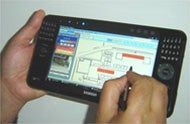Background
The value of large institutional assets including property, facilities, and equipment in North America is in the trillions of dollars. The effective management of the maintenance of such large capital asset platforms is very complex which makes it challenging to effectively allocate maintenance spending in an optimized way. The estimated maintenance and repair expenditure requirements in Canada are of the order of CDN$110.0 billion per year and in the U.S. such costs are of the order of US$800 billion per year. Given such significant annual spending, there is a constant demand for tools and services that can better allocate resources to asset maintenance activities.
Description of the invention
The VAM system offers several key novel differentiating capabilities from competitive tools. Firstly, VAM utilizes a small hand held computer tool to easily enter inspection data, including direct linking of electronic floor plans to photos taken from the site. This on-site data entry capability simplifies the data collection step and reduces the chances of data transcription errors associated with conventional paper based manual practices. The VAM system also utilizes a novel methodology to predict the condition of assets based on analyzing historical asset maintenance data. This feature offers the potential to significantly reduce the number of physical inspections required to survey overall asset condition and thus stands to reduce the end users inspection costs. The VAM system also utilizes sophisticated algorithms to enable budget allocation decisions based on optimization mathematics (that would previously require a supercomputer to calculate) that considers all combinations of asset condition state versus the costs to repair. This feature stands to either allow asset managers to spend less on repairs or to enable more repairs for the same budget amount. Both the condition prediction and budget allocation optimization capabilities are unique to VAM. Lastly, VAM is being developed to include elements of the LEED green initiative standard to address building sustainability and energy efficiency issues.
Advantages
- Accurate and speedy on-site data entry and 3D visualization
- Condition prediction methodology reduces number of inspections
- Novel algorithms enable optimized budget spending
Potential applications
- Maintenance and capital renewal decision support for mid-large organizations (e.g. school boards, universities, utility operators, property managers, mining, etc.)

Reference
8810-7256
Patent status
Use case validated software
Stage of development
Prototype developed and field testing underway
Contact
Scott Inwood
Director of Commercialization
Waterloo Commercialization Office
519-888-4567, ext. 33728
sinwood@uwaterloo.ca
uwaterloo.ca/research